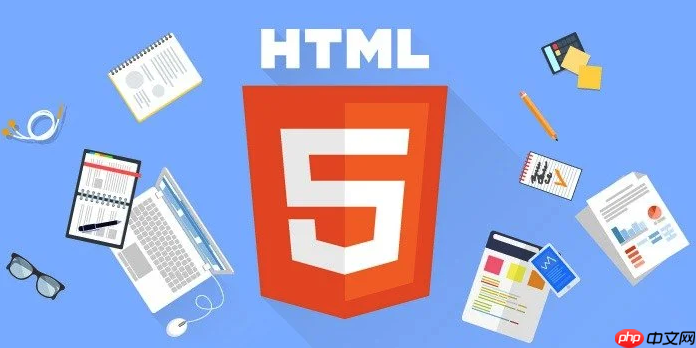最直接的方法是使用css的:last-child伪类,它能选中父元素的最后一个子元素,无论类型;2. :last-child与:nth-last-child(1)功能等价,但后者更灵活,可选倒数第n个;3. :last-of-type选择同类型子元素中的最后一个,而:last-child关注所有子元素中的物理位置;4. 常见应用场景包括去除列表末尾边距、导航分隔符处理、表单布局调整和动态内容样式控制;5. 注意事项包括理解“直接子元素”概念、避免优先级冲突、区分:last-child与:last-of-type的逻辑差异;6. :last-child与:first-child、:nth-child同属结构性伪类,均基于位置选择,但方向不同,且不依赖元素类型;7. 当一个元素同时是:first-child和:last-child时,等同于:only-child。这些伪类让开发者无需修改html即可实现精准样式控制,提升代码的灵活性和可维护性。

想给HTML里某个容器的最后一个子元素设置样式?最直接、也是最常用的办法就是利用CSS的
:last-child
要给HTML中的最后一个子元素设置样式,我们通常会这样做:
假设你有一个列表结构,比如一个
<ul>
<li>
立即学习“前端免费学习笔记(深入)”;
<ul class="my-list">
<li>列表项1</li>
<li>列表项2</li>
<li>列表项3</li>
<li>列表项4</li>
</ul>如果你想让“列表项4”有特别的样式,比如边框或不同的颜色,CSS代码会是这样:
.my-list li {
margin-bottom: 10px; /* 给每个列表项一个下边距 */
border-bottom: 1px solid #ccc; /* 给每个列表项一个下边框 */
padding: 5px;
}
.my-list li:last-child {
margin-bottom: 0; /* 移除最后一个列表项的下边距 */
border-bottom: none; /* 移除最后一个列表项的下边框 */
color: blue; /* 给它一个特殊的颜色 */
font-weight: bold;
}这段CSS的意思很明确:先给所有
<li>
.my-list li:last-child
<ul>
<li>
<li>
class="last-item"
嗯,除了
:last-child
首先,最接近
:last-child
:nth-last-child(1)
li:last-child
li:nth-last-child(1)
:last-child
nth-last-child
然后是
:last-of-type
<div>
<p>段落1</p>
<span>跨度1</span>
<p>段落2</p>
<span>跨度2</span>
<p>段落3</p>
</div>如果你用
p:last-child
段落3
div
p
<span>跨度2</span>
<span>跨度3</span>
p:last-of-type
段落3
p
span:last-of-type
跨度2
类似地,还有
:nth-last-of-type(1)
:last-of-type
所以,核心区别在于:
:last-child
:last-of-type
选择哪一个,取决于你的具体需求。如果你的容器里只有一种类型的子元素(比如
<ul>
<li>
在实际开发中,
:last-child
消除列表或网格的末尾边距/边框:这大概是最经典的用法了。比如你有一堆卡片或列表项,每个之间都有一个下边距或者右边距,但最后一个元素后面就不需要这个边距了,否则会造成布局上的额外空白。这时候,
li:last-child { margin-bottom: 0; }div.item:last-child { margin-right: 0; }导航菜单或面包屑导航的特殊样式:在一些导航条里,最后一个菜单项可能不需要分隔符,或者有不同的字体颜色、背景色来突出显示。例如:
nav ul li {
padding-right: 10px;
border-right: 1px solid #eee;
}
nav ul li:last-child {
border-right: none; /* 移除最后一个菜单项的分隔符 */
font-weight: bold;
}表单元素分组的布局调整:有时候表单里有一些连续的输入框或按钮组,你可能希望最后一个元素在布局上有些微调,比如独占一行,或者边距不同。
动态内容列表:当你的列表内容是动态生成的时候(比如通过API请求数据渲染),
:last-child
至于注意事项嘛,有几点我觉得挺重要的:
理解“子元素”的含义:
:last-child
div:last-child
div
div
div
div
div > *:last-child
div p:last-child
优先级问题:和其他CSS选择器一样,
:last-child
:last-child
:last-child
:last-child
兼容性:
:last-child
与:last-of-type
要说
:last-child
:first-child
:nth-child
相同点:
它们都属于结构性伪类,不依赖于元素的类名、ID或属性,而是根据元素在DOM树中的结构位置来选择。它们都是在父元素的直接子元素中进行判断和选择。比如,
ul li:first-child
ul li:last-child
ul li:nth-child(2)
ul
li
不同点:
选择方向和位置:
:first-child
:last-child
:nth-child(n)
n
n
nth-child(3)
nth-child(even)
nth-child(odd)
nth-child(2n+1)
“类型无关”的特性:
:first-child
:last-child
:nth-child
<div>
<p>第一段</p>
<span>第一个span</span>
<p>第二段</p>
</div>div p:first-child
div
<p>第一段</p>
p
div
div p:first-child
第一段
<p>第一段</p>
div
div span:first-child
<span>第一个span</span>
div p:last-child
第二段
div
<p>第二段</p>
<span>第一个span</span>
p
div
第二段
p
div p:last-child
p
p
第二段
div
div p:last-child
<div>
<p>第一段</p>
<span>第一个span</span>
<p>第二段</p> <!-- 这个p是最后一个子元素 -->
</div>在这种情况下,
div p:last-child
第二段
第二段
p
div
与:only-child
:only-child
:first-child
:last-child
:only-child
总的来说,这些伪类都是CSS提供给我们的强大工具,能够让我们在不修改HTML结构的前提下,根据元素在DOM树中的相对位置进行精确的样式控制。
:last-child
以上就是HTML如何设置最后一个子元素样式?last-child伪类的作用是什么?的详细内容,更多请关注php中文网其它相关文章!

HTML怎么学习?HTML怎么入门?HTML在哪学?HTML怎么学才快?不用担心,这里为大家提供了HTML速学教程(入门课程),有需要的小伙伴保存下载就能学习啦!

Copyright 2014-2025 https://www.php.cn/ All Rights Reserved | php.cn | 湘ICP备2023035733号